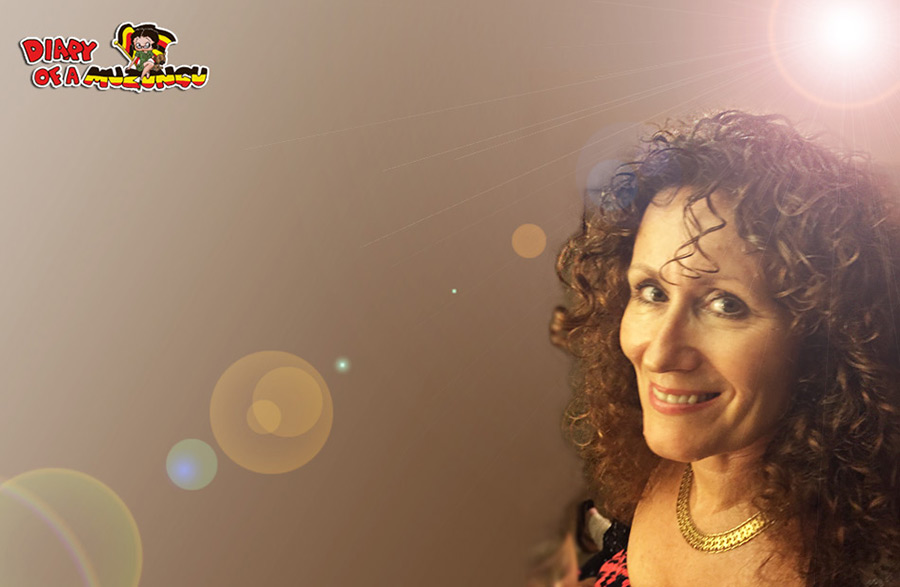
Visit these two brilliant community tourism projects in Ishasha: Deo’s Homestead Tour and Agartha’s Taste of Uganda Tour

Diary of a Muzungu with Deo the farmer and his family, on the edge of the elephant trench that borders Queen Elizabeth National Park. Here Deo is showing us how he burns chilli and elephant dung to deter elephants from crossing the trench into his garden

One of Deo’s sons illustrates how big an elephant’s footprint is! Maintaining the trench is a constant job. Elephants, buffalo and bushpigs can access the trench from poorly maintained sections. Standing in the elephant trench. Ishasha, Queen Elizabeth National Park

Signpost to Deo’s Model Homestead Tour, a community tourism project in Ishasha. Leaving Kihihi trading centre, drive for 20 minutes, through the next trading centre. Deo’s is on the left, immediately before the park boundary. His homestead is a few minutes drive from the main road
You might not believe it but it was elephants – or what comes out of the back end of them – that first brought me to Uganda.
Colleagues back in London laughed out loud when I told them about the first project that the Uganda Conservation Foundation had planned for me: collecting elephant dung with the Uganda Wildlife Authority, all part of a global project to analyse and map elephant DNA and crack down on ivory poaching.
“No shit?”
As it turned out, some other lucky bugger got this job, not the muzungu. Several weeks bouncing around in a 4 x 4 looking for elusive elephants may not have been quite as glamorous as I first thought anyway …

Diary of a Muzungu’s first visit to an elephant trench. This trench, also funded by the Uganda Conservation Foundation, is at Kikarara, in south western Uganda. Ideally, it should measure 2 metres wide by 2 metres deep, to stop elephants crossing into the fields of crops
Regardless, the muzungu has a soft spot for elephant dung (yes, I know ‘I have issues’) so I was delighted to be invited on my next adventure with Julia, heading back to Ishasha, south western Uganda, to check out Deo’s Homestead Tour (originally developed and funded as part of the Ishasha Community Uplift Project).
What – no bananas? No baby Dillon to bounce on my knee?
Community tourism, elephant conservation, a chance to meet the farmers, solutions for managing ‘human wildlife conflict’ – this very cool project ticks all the right boxes for me – with OR without bananas.

Sun rises over the fields of Ishasha, south western Uganda. Deo sleeps in this guarding hut every night on his land, away from his family, on the look-out for hungry elephants that may eat or destroy his entire harvest in just a half an hour. Here he’s holding a lump of elephant dung (and a panga machete).
Deo was full of smiles and runs a great Model Homestead. This charming little girl is one of his daughters. The even more charming muzungu is Yours Truly of course, ha ha, bleary-eyed after a night’s camping with Julia and no morning tea! EH BANANGE!

Meet Deo’s family. The whole family is involved in the tour of the model homestead. We felt very welcome!

Deo explains how the tippy tap works, as his daughter gives us a demo. This simple construction of a foot-powered wooden ‘pedal’ tips the water from the jerry can. It means people can wash their hands without touching anything, and helps reduce the spread of germs. Clever eh? Community tourism in Ishasha, Uganda
After two and a half years fundraising to protect farmers such as Deo and his family from crop raiding elephants, it was quite an honour to be invited to tour Deo’s Model Homestead in Ishasha, bordering Queen Elizabeth National Park. Deo’s community tourism project was originally part of the Ishasha Community Uplift Project but has been managed by Deo himself since 2017. Deo and Agartha (a neighbouring lady farmer) stood out as exceptional members of their community group, transforming their homes (and thus their incomes and their health) into ‘model homesteads.’ Community tourism projects like these are the perfect way to show tourists how rural Ugandans live.
Below, Deo burns a combination of elephant dung and homegrown chilli as a deterrent to would-be elephant encroachers. He was very proud to show us his techniques – but boy he lives on the edge. Fancy doing this every night, just to survive?

Elephant dung deterrent used by Deo the farmer in Ishasha, Queen Elizabeth National Park
As well as a welcoming grin, Deo of course has an extra special feature: The Elephant Trench! – and he sure is proud of it!

Visitors to the trench are invited to get their hands dirty, literally! Felex Kamalha of UCOTA does his part. Rain can make the sides of the trench crumble. Hungry animals can soon find weak areas of the trench wall and attempt to cross into the fields of crops

Huge credit to (almost Dr.) Julia Lloyd who has been working hard to develop this brilliant interactive and educational tourism experience. Developing a community project and teaching the customer service skills expected by tourists can be challenging. The project is now self-sustaining!

When crop raiding animals approach his fields, Deo beats the jerry can loudly with a stick. This helps deter the animals and alerts the family and neighbours to come and make noise too

Deo shows Diary of a Muzungu how to use a machete to prune the banana plant. Stripping the dead leaves, with a diagonal slice of the machete, prevents water collecting and rotting the stem

One of the family shows us his wooden bike. The ‘Kihihi bike’ is actually an Eastern Congolese invention known as the chukudu or chikudu, and is used for transporting heavy goods. At Deo’s the kids play on it. Deo’s model homestead is approximately half an hour from the Congolese border by road

Deo’s Homestead Tour takes in fields of maize, bananas and medicinal plants. Here one of Deo’s sons climbs a jackfruit tree to see whether it is ripe. I love this project!

Inside the latrines at Deo’s Model Homestead. Note the soft leaves of the ‘toilet paper’ and the banana fibre basket lid cover over the hole of the pit latrine. The latrine is clean, does not smell and has no flies – a lot cleaner than the average toilet in Kampala!
We’re off to Kihihi again next week to see how Deo’s been getting on. I wonder what stories Deo will have in store for us? Which of his livestock has the leopard run off with this time? And more importantly, have the elephants visited recently?
How to book Deo’s homestead tour, Ishasha
Deo is a working farmer so please call him one or two days before you plan to visit him to make sure he is available. His phone number is +256 (0)781 201368. (His tour was developed through the Ishasha Community Uplift Project but he now runs his tour independently).
Agartha’s “Taste of Uganda” is now the main Ishasha Community Uplift Project tourism experience. Read all about it here How to be a Mukiga woman – meet Agartha!
To book Agartha’s, call one or more days in advance. Call the Wild Frontiers office on +256 (0)41 4322551 / 0772 721155 or call Agartha directly on 0776 453121. Note that the community are working farmers and need to plan for your arrival.
Sign up to the Muzungu’s occasional newsletter to read about these and other great community tourism projects!



























I love your blog!
Thanks Camelia! 🙂
I love it! Although at first the elephant dung didn’t appeal me, the project it is amazing!
I am really looking forward to visit Uganda next month! 😀
Thanks Isabel, I know you will LOVE Uganda!
Brilliantly funny blog – keep up the good work!
Thanks Em! I never run out of things to write about Uganda 🙂
I love the story
Thanks Celestine, I really loved visiting Ishasha and seeing the world thru a farmer’s eyes.
EXCELLENT COMMUNITY TOURISM PRODUCT. GOOD WORK AND KEEP US POSTED
Thanks for your feedback Helen. I hear this is now a recognised UCOTA community tourism project? Excellent news!
Ha ha ha……… all that poop! Reminds me of when we had to make paper from rhino dung here at UWEC……………….
It doesn’t smell tho does it? You’d think it would! Elephant dung and abattoirs, I bet everyone’s glad I haven’t added smells to my blog, as well as music!
Hey, I never look that great after a night of camping!
Great blog… love the sense of humour… definitely going to be stopping in more often!
Glad you enjoyed the blog Colleen 🙂 Ugandans have a great sense of humour. Kind of rubs off on you!
the downside of camping in remote areas is that you’re miles away from a decent mirror -couldn’t even see in the car wing mirror for dust! Usually find after two days roughing it, I’ve given up on the appearance / washing / delete as appropriate! thanks for stopping by!
Loved your story. Visited Uganda last month and met Deo and Agatha so related to your story. Hope anyone reading your piece will be encouraged to visit them to, lovely people who gave me very meaningful experiences.
Hi Roy, thanks for commenting. Isn’t Deo’s Homestead Tour one of the best tourism experiences ever! I absolutely loved it. Have visited it three times now. Incredibly good value for money as well, since Agartha’s “Taste of Uganda Tour” is also included in the $15 fee per visitor.
Brilliant to hear the project is now self-sustaining. The community are investing in a SACCO savings and credit scheme and have even been investing in goats and chickens. I think that’s pretty impressive for a project that’s only been going three years. It is monitored and promoted by UCOTA Uganda Community Tourism Association now, which will really help put it on the map.
I hope that one day everyone travelling from Queen Elizabeth National Park through Ishasha onto Bwindi – and vice versa – stops to pay Deo and Argatha a visit.
UPDATE: On Friday 20th November I had the honour of accepting the Best Community Tourism Project award on behalf of the Ishasha Community Uplift Project in Uganda’s inaugural Tourism Excellence Awards.
Ishasha Community Uplift Project is the formal name for Deo’s Homestead Tour and Agartha’s ‘taste of Uganda’ Tour. How exciting, not just for Deo and Agartha, but for community tourism in Uganda generally. This project is a brilliant template for tourism, conservation and the community – all benefiting equally. Am delighted for everyone involved.
I’ve been a regular visitor to these two community tourism projects since 2012 and highly recommend both.
I enjoyed reading about your project and your adventures.I also liked the fact that there is no snobbery in the way you see things.Very refreshing.Thank you.
P.S:I am a semi-retired doctor at Médecins Sans Frontières Ukraine.I worked in Gulu,Uganda for 3 years and in some other 17 countries.
Hi Alexander, thanks for your positive feedback.
Hats off to you by the way. MSF do amazing work!
How did you find life in Gulu?